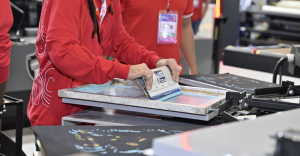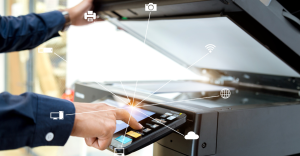Custom embroidery is on the rise, with growing demand from consumers who value exclusivity and a personalized touch in their products. This artisan technique, which adds value and uniqueness to items, is driving the personalization and crafts markets forward. Whether in fashion, home décor, or promotional items, embroidery offers a versatility that appeals to a diverse audience, making it a powerful tool for boosting results in businesses across various sectors and market approaches.
Despite being a traditional technique with classic aesthetic appeal, embroidery has evolved with technology, allowing for the creation of complex, detailed designs using computerized machines. This advancement has also optimized production time and made it scalable—particularly important for businesses offering embroidered uniforms, for instance.
For entrepreneurs in the sector, adding custom embroidery to their product catalog can be an effective strategy to stand out from competitors and drive sales, directly impacting business results. In this article, learn how embroidery can add value to your business and find out where to start.
Why Is Custom Embroidery Popular?
Embroidery is an artisanal technique that has existed for centuries and remains relevant today, especially as consumers increasingly value product personalization. With technological advancements, embroidery has adapted, allowing for the creation of intricate designs with computerized machines while maintaining the handcrafted appeal many consumers seek.
According to Maik Pereira, Product Specialist for Embroidery Machines and Textile Printers at Brother Brazil, custom embroidery can add value for a variety of target audiences, from small entrepreneurs looking for additional income, to personalization companies focusing on uniforms and promotional items, and even larger ateliers and clothing manufacturers. “Single- and multi-brand stores, as well as department stores, also have great potential in the embroidery market for expanding their business, given that they offer a product with higher added value,” says Pereira.
Additionally, embroidery is highly versatile and can be applied to a range of products. In the fashion industry, it can be used to add details to clothing such as shirts, caps, and jackets. For home décor, this technique allows for the customization of towels, cushions, and curtains. In the promotional sector, embroidery can be incorporated into items like backpacks, cases, toiletry bags, and other promotional products.
Reasons to Include Embroidery in Your Catalog
According to the specialist, more and more consumers are looking for something unique and exclusive, with the fashion sector often serving as the starting point for expressing identity through personalization. “Embroidery allows this expression to come to life—enabling, for example, the production of a jacket with an embroidered patch of your favorite band’s logo, the customization of company uniforms, or even intricate embroidery on your favorite piece of clothing,” says Maik. “Besides the fact that embroidery tends to last longer (compared to other personalization techniques), it also adds value to the product being sold,” he adds.
Custom embroidery offers numerous benefits for businesses in the promotional gifts and items sector. Some key advantages include:
- – Competitive Differentiation: Embroidered products have a unique visual appeal and touch of exclusivity that is not easily replicated by competitors.
- – Value Addition: Embroidery increases the perceived value of products, allowing for higher price points on personalized items.
- – Versatility: The ability to embroider on a wide variety of materials and products enables entrepreneurs to expand their portfolio to different markets.
How to Start Offering Custom Embroidery.
To begin offering custom embroidery, it’s important to follow a few steps. For example, identifying your target audience is essential for understanding who your potential customers are and selecting products for your portfolio accordingly.
Choosing the types of embroidery is another crucial step, as this will also determine which machine to invest in. Investing in a quality machine is essential to ensure the precision and durability of the embroidery. Additionally, creating a portfolio with samples of your work can help attract clients and showcase your services.
Identifying the Target Audience
Companies in the corporate gifts, events, or fashion sectors are excellent examples of audiences that benefit from embroidery services. Properly segmenting your target audience also helps in choosing which products to focus on. Personalized clothing, accessories, corporate gifts, and decorative items are generally good options, but it’s important to assess market demand both locally and on social media.
Your business could focus on the B2B market, for example, specializing in a portfolio of gifts for corporate events. Another option is to target niches like professional lab coats (for veterinarians, doctors, teachers, etc.), custom uniforms (for companies and sports teams), or custom-made gifts (with designs developed in collaboration with the client).
Choosing Embroidery Types and Equipment
Today’s market offers a wide range of embroidery machines, from home-use options for small entrepreneurs to robust industrial models suited for large-scale production. The choice of equipment depends directly on your business model and expected production volume.
Computerized machines are highly recommended, as they allow you to create detailed embroidery from digital files, enabling complex designs with high levels of customization, precision, and consistency.
When selecting your embroidery machine, consider factors such as precision, speed, and the durability of the finished pieces. Additionally, take into account the availability of technical support and spare parts—information that can often be obtained from the machine’s sales team.
According to Maik Pereira, it’s essential to consider the dimensions of the embroidery area to ensure that the design/image fits within these limits. Also, keep in mind the number of colors used in the embroidery, as frequent thread changes can be a hassle. Other points highlighted by the specialist include evaluating the features and technologies offered by the machine, “such as operating speed, automatic needle threading, hoop recognition, automatic thread cutting, Wi-Fi and USB connectivity, among others,” he explains. “And the most important aspect: choosing a machine from a reputable brand that provides excellent customer support and after-sales service,” he concludes.
How to Promote Your Embroidered Products
Once your custom embroidery business is established, promoting your products is essential for reaching your audience and boosting sales.
Social Media and Online Presence
Having a presence on social media is indispensable for any business offering personalized products. Platforms like Instagram, Facebook, and TikTok are powerful tools for sharing photos and videos of your embroidered items, interacting directly with customers, and showing behind-the-scenes glimpses of your production process.
Posting before-and-after shots of embroidered products, videos of the personalization process, and customer testimonials are effective strategies for creating a more personal and engaging connection with your audience on these platforms.
Event Participation
Beyond digital marketing, participating in events and trade shows can be an excellent way to promote your custom embroidery. These events allow you to showcase your products in person, creating opportunities for direct interaction with potential clients. Additionally, they’re great for forming partnerships and making sales.
Partnerships and Collaborations
Another effective way to promote your products is through strategic partnerships with other businesses or influencers. For example, you could establish agreements with corporate gift or event companies to provide custom embroidered products, thus expanding your business’s reach and attracting new customers.
Building partnerships can be an excellent way to broaden your audience and draw in new clients. Consider collaborating with other brands to create joint products like customized clothing, accessories, or home décor items. These partnerships can help boost your work’s visibility and reach new audiences.
Creating a Portfolio
A well-crafted portfolio is essential for attracting clients and showcasing the quality of your services. Include photos of previous work, highlighting the variety of products and designs you can offer. Additionally, consider creating embroidery samples on different types of fabrics and products to demonstrate the versatility of the technique.
An online portfolio, on a website or social media, can be an excellent way to reach a larger audience and make information easily accessible. Ensure the photos are high-quality and show the embroidery details clearly. Including testimonials from satisfied customers can also enhance the credibility of your work.
Custom Embroidery: An Opportunity for Your Business
Incorporating custom embroidery into your business can be an excellent strategy to stand out in the personalization market and boost your sales. With the growing popularity of this technique and its application across various sectors, embroidery has the power to add value and exclusivity to products.
With dedication and the right tools, your business can achieve even greater success by offering custom embroidery!




